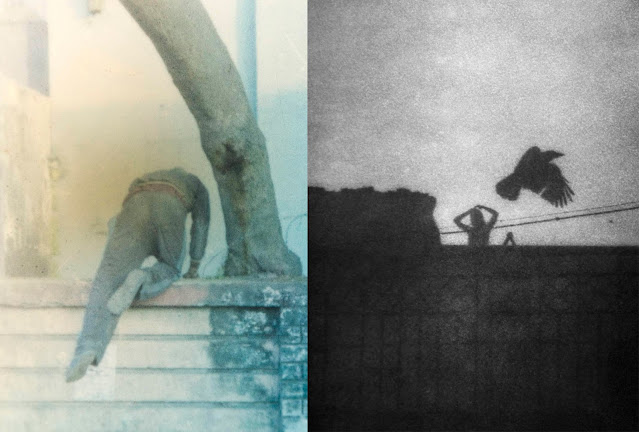 |
Passenger by Martin Bogren.
|
Photographs by Martin Bogren
La Main Donne, France, 2021. 92 pp., 50 color and duotone illustrations, 7¼x10¼".
For some ‘passenger’ is a word associated with travel, adventure, wayfarers, hitchhikers, pilots and pilgrims. For others, it’s anxiety-inducing. Seatbelts. Emergency exits. Sweat. Some people prefer to drive, even insist on it. I waver depending on the circumstance. If I’m photographing I prefer to look, my feet up on the car dash, the window down enough to flutter the stray fronds of blonde above my ears. I like knowing I’m seeing things the driver cannot, feeling things the driver cannot.
Passenger by the Swedish photographer Martin Bogren is not a photobook you pass through like a small town on your way to the city. Published by Editions Lamaindonne, it is Bogren’s tenth book. It comprises fifty photographs taken in Kolkata (formerly Calcutta), the capital of India’s West Bengal state, during three winters from 2018 to 2020. This is a book for a longer linger, like that place you stopped at years ago that still holds a piece of you. It’s a book of blur and grain, loose light and shy shadows that make it seem like life is passing you by at the speed of photography.
If you enjoy clear, sharp, formal, frontal photographs this book may not appeal. Bogren prefers haze, patina, silhouettes, twinning, glares and many shades of grey. Not everything that Bogren points his camera at is immediately recognizable. At times, he is awkwardly or bluntly close, at others wistfully distant.
 |
Kolkata is a large and vibrant city of contrasts and contradictions. Bogren overlooks the large and vibrant in favor of the latter. He embraces contrast both through technique and metaphor. His images show bodies climbing, resting, embracing, reaching or waiting. Jackdaws making eye contact with people and each other. Shoes, hats and hangers waiting for action. Absence of the female body in this book is palpable. In Bogren’s words, “what came to me after a while was a story about men, boys, old men, kids and youths, all in a quite sad and solitude context [sic] in the lack of women or female energies.”
Bogren’s images are out-in-the-open secrets that might otherwise go unnoticed. They remind me of those in Nancy Rexroth’s Iowa, published in 1977, taken in southeastern Ohio with a toy camera. They share similar aesthetics and a sense of being everywhere and nowhere at once. Both photographers turn place into a sequence of emotional states. The pacing of the images emphasizes their psychological quotient.
When we’re a passenger, our body occupies another body, that of a vehicle. When we photograph, the camera is a body we ‘drive’ and control. Yet a single photograph can surprise by asserting influence and control over us. It can transport us and take us for quite a ride. There are two images I had to know more about, and Bogren kindly shared with me the details in an email exchange. The first is a black-and-white image taken in the morning at a railway station. It depicts a body waiting to be removed and thus covered. The second is the remains of a clay sculpture-idol at the edge of a river. The day I am writing this review, on the front page of The New York Times is a photograph of the body of a Russian soldier near Kharkiv, Ukraine. Much has been written about the tensions, paradoxes and accountabilities of looking and seeing bodies. I highlight these images because regardless of treatment — in Bogren’s case with seductive soft focus — it’s essential to be an informed, ethical and constructive viewer of images of all bodies (whether alive or deceased). Which takes me back to being a passenger and how for some, it’s uncomfortable because they feel vulnerable and exposed. We have a responsibility to be so much more than passengers in all that we look at, and all that we photograph.
 |
I can’t think of the word ‘passenger’ without thinking of the singer Iggy Pop. I think of him now in context of Bogren (whose first book The Cardigans, Been It was published in 1996 after several years touring with the band). Both artists composing on-the-spot, Pop in the studio, Bogren on the streets of Kolkata. Let’s take a ride and see what’s mine, whirrs Pop. This applies to Bogren’s work. No photograph we take is ever ours alone. Whenever we photograph we intrude and we must question not only if we’re doing it with respect and grace but why we are photographing at all. I am the passenger, I stay under glass. Bogren is a passenger, looking through the glass of his lens while also free from it. What does he see? Take a ride with Passenger and look.
Purchase Book
Read More Book Reviews
 |
 |
 |
Odette England is a photographer and writer based in Providence, Rhode Island and New York. Her work has been shown in more than 100 museums, galleries, and exhibition spaces worldwide. She has two photobooks out this year: Dairy Character, winner of the 2021 Light Work Book Award; and Past Paper Present Marks: Responding to Rauschenberg, her collaboration with Jennifer Garza-Cuen, which received a $5,000 Rauschenberg Publication Grant.










